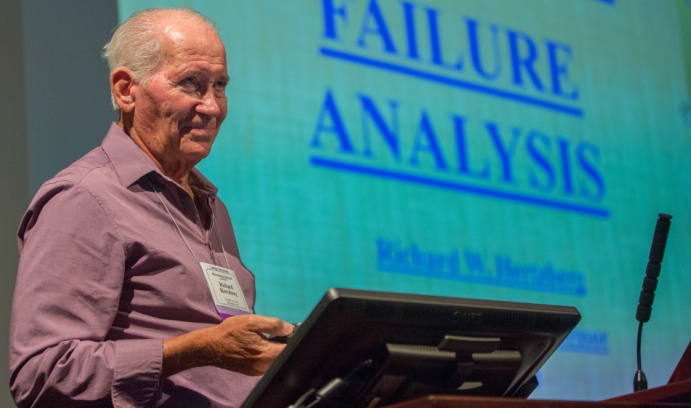A Lifelong Learner Comes Full Circle

At Lehigh’s annual Microscopy School last month, Richard Hertzberg lectured on the analysis of fracture surfaces and on failure analysis, both using the scanning electron microscope. (Photo by Christa Neu)
When you have an unwavering passion for what you do, Richard Hertzberg has found in retirement, you never know where it will lead you.
“I love to explore,” says Hertzberg. “I love to learn. And I love to teach.
“To me, teaching is like theater. When I’m in front of a group of students, I often find that I’m hyperventilating by the time I’ve finished.”
Hertzberg retired two decades ago as the New Jersey Zinc Distinguished Professor in Lehigh’s department of materials science and engineering. An expert in fracture mechanics, he spent his career studying the cracks that form and spread in airplanes, bridges, ships and other structures.
At Lehigh, Hertzberg gave classes to undergraduate and graduate students, postdocs and industry engineers, and high school science teachers.
Since retiring, he has lectured to a variety of lay audiences, from adult education classes to elementary and high school students.
Why did the Liberty Bell crack? Hertzberg will ask a class of teenagers or ten-year-olds. Why did the Titanic sink so quickly after its fatal brush with an iceberg? By examining an extremely small surface in a bridge connection or airplane wing—often with an electron microscope—it is possible to determine how a crack formed and how it propagated and caused an entire structure to fail.
“The details on a fracture surface,” he says, “are like the fingerprints of a murder suspect on a glass of water.”
Hertzberg, who earned his Ph.D. from Lehigh in 1965, has received Lehigh’s Libsch Award for Outstanding Research, the College of Engineering Teaching Excellence Award and the Hillman Faculty Award for advancing the interests of the university. The department of materials science and engineering named him its distinguished alumnus in 2015.
In 2000, Hertzberg was named the most outstanding materials science educator in the United States by The Metallurgical Society (TMS), the nation’s preeminent professional materials organization.
This spring, Hertzberg received the 2017 Paris Gold Medal from the International Congress on Fracture (ICF) for his contributions to the field of fatigue fracture. The award, given every four years, is named for the late Paul C. Paris, who was Hertzberg’s Ph.D. dissertation adviser at Lehigh. Paris developed the Paris Law of Crack Propagation—a model of fatigue crack growth now used worldwide.
Richard P. Vinci, professor of materials science and engineering, says Hertzberg’s work with fatigue—the structural failure brought on by repeated cycles of stress—underlies many of the safety standards adopted by the aircraft and automobile industries.
“Dick worked with Paul Paris and others in the 1960s and 1970s to establish the theoretical and mathematical foundation for fracture mechanics,” says Vinci, who directs Lehigh’s Center for Advanced Materials and Nanotechnology. “He contributed to the rapid adoption of this approach in the aircraft industry through a series of important short courses that he delivered to industry and military personnel.”
Hertzberg also gained renown for his textbook, Deformation and Fracture Mechanics of Engineering Materials, first published in 1976 and now in its fifth edition, which has been translated into several languages.
The production of the book’s latest edition in 2012 became something of a family affair. Hertzberg co-wrote the book with Vinci and with his son, Jason L. Hertzberg, who is corporate vice president of Exponent, an engineering consulting firm in Chicago.
“I asked Rick and my son to be coauthors,” Hertzberg says. “Both of them accepted. My son has his Ph.D. from the University of Michigan. His work includes product recall and failure analysis.
“Rick is the person Lehigh hired to take my place when I retired. I consider him to be my academic son. We have a very close relationship. He’s a wonderful human being.”
In retirement, Hertzberg moved to Naples, Florida, and began teaching courses in fracture mechanics to adults with little knowledge of the topic. He called the course “Resolving the Mysteries of Famous Fractures” and drew as many as 90 people eager to learn about the Liberty Bell, the Titanic and other structures.
He also contacted local schools and began teaching the principles of fracture to elementary and high school students. To this version of his course he gave the title “Why Stuff Breaks.”
How does he present a technical topic to young learners with little background in science and engineering?
“Use little words,” Hertzberg says, “and age-appropriate examples of real-life failures. You don’t want to intimidate kids.”
Several years ago, while he and his wife were visiting their daughter in Michigan, Hertzberg offered to give a lecture to his grandson Henry’s third-grade class.
“The teacher said, ‘Great! But Henry’s younger sister is in first grade. Can they come too?’ There must have been 70 or 80 kids on the floor of the school library,” says Hertzberg. “And no one had told my grandkids that their grandfather would be the speaker.”
Two years ago, Hertzberg became restless.
“I decided I had to do something different,” he says. “I went online to study a new subject. I ended up giving a 90-minute lecture to a class of adults on the Louisiana Purchase and the Lewis and Clark Expedition. I’ve given this class four or five times now to an adult education group in Naples.”
Last winter, Hertzberg studied and lectured on another new subject—the Dust Bowl, a period of severe dust storms and drought that ravaged the Great Plains in the 1930s.
Now Hertzberg finds himself drawn to the early history of the railroad. What was it like, he wonders, to ride the rails in Victorian England and Lincoln’s America?
“This is an absolutely fascinating period of history,” he says. “I’ve learned so much. The first English rail service began in 1830. Prince Albert took his first train trip in 1838 and Queen Victoria in 1841. Railroad mania spread through the country, and people petitioned Parliament to build hundreds of railroads.
“Then I came across an incredible connection with my earlier fatigue research. In 1846, there was a major failure of a railroad bridge. I did some research and found two papers that were written in the last 10 years on the probable cause of the failure of that bridge. I had so much material that I decided to expand my class to a series of two lectures.
“Then I learned that in 1847, Queen Victoria called for the establishment of a commission to study the failure of iron bridges. Two years later, the commission reported that these bridges were failing because of fatigue. So I’ve now come full circle.
“You can see how excited I get when I see the pieces coming together. I just love it. I love exploring and find out new things, and I love to share my enthusiasm.”
Story by Kurt Pfitzer
Posted on:




